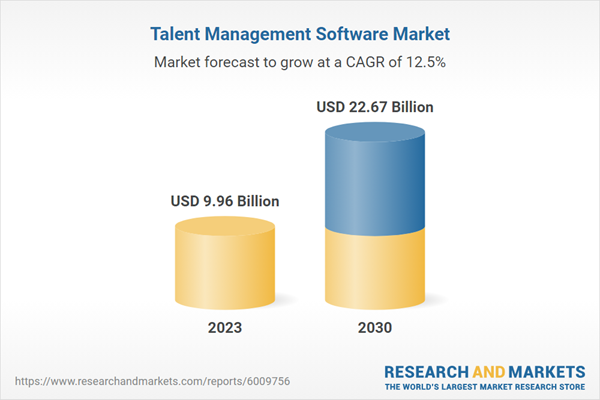The global talent management software market size is expected to reach USD 22.67 billion by 2030, registering a CAGR of 12.5% from 2024 to 2030. The talent management software industry is anticipated to undergo a series of changes owing to various factors such as decreasing employment rate, changing work environment, the rise of freelancing and contract work, and a globalized workforce.
The most pertinent of the factors is the advent of new software and technologies, such as big data analytics, social media, and the Internet. Mobile platforms are also revolutionizing some important talent management stages, such as recruitment and learning & training, thus driving competition in the market.
Industry leaders have been providing the products in the market for quite some time now but trends such as transparency, customization, and employee engagement are expected to be at the forefront of the new and upcoming offerings to customers. The increasing use of analytics to map the performances and predict the future outcomes has also had a positive effect on the adaptation to the technology in demand.
Solution integration and the availability of middleware from vendors are also an important step forward for the industry standardization. As the industry strides toward larger adoption and rapid developments in terms of capabilities, many new trends such as Massively Open Online Courses (MOOCs) and social media adherence, for either pre-hire assessment or employee feedback management, are gaining traction in the market.
This product will be delivered within 1-3 business days.
The most pertinent of the factors is the advent of new software and technologies, such as big data analytics, social media, and the Internet. Mobile platforms are also revolutionizing some important talent management stages, such as recruitment and learning & training, thus driving competition in the market.
Industry leaders have been providing the products in the market for quite some time now but trends such as transparency, customization, and employee engagement are expected to be at the forefront of the new and upcoming offerings to customers. The increasing use of analytics to map the performances and predict the future outcomes has also had a positive effect on the adaptation to the technology in demand.
Solution integration and the availability of middleware from vendors are also an important step forward for the industry standardization. As the industry strides toward larger adoption and rapid developments in terms of capabilities, many new trends such as Massively Open Online Courses (MOOCs) and social media adherence, for either pre-hire assessment or employee feedback management, are gaining traction in the market.
Talent Management Software Market Report Highlights
- The human resource departments are responsible for decisions concerning talent management systems and are witnessing a shift toward integrated solutions
- Organizations, they are in search of platforms to integrate the disconnected systems
- As the industry is moving toward digital management and cloud-based applications, there is a looming threat of data breaches and hacking incidents
- The industry may also witness a rise in the number of small companies and start-ups that address the niche markets and provide customized solutions while being susceptible to acquisitions and mergers of smaller firms as well as the entry of technology giants to capitalize on the market opportunities
The leading players in the Talent Management Software market include:
- Cornerstone
- DelTek, Inc.
- ADP, Inc.
- Bamboo HR LLC
- IBM Corporation
- Learning Technologies Group Plc.
- Oracle Corporation
- Talented Learning LLC
- SAP SE
- Dayforce, Inc.
- UKG Inc.
- Cegid
- Workday, Inc.
- 15Five, Inc.
- Mercer LLC
Why should you buy this report?
- Comprehensive Market Analysis: Gain detailed insights into the global market across major regions and segments.
- Competitive Landscape: Explore the market presence of key players worldwide.
- Future Trends: Discover the pivotal trends and drivers shaping the future of the global market.
- Actionable Recommendations: Utilize insights to uncover new revenue streams and guide strategic business decisions.
This report addresses:
- Market intelligence to enable effective decision-making
- Market estimates and forecasts from 2018 to 2030
- Growth opportunities and trend analyses
- Segment and regional revenue forecasts for market assessment
- Competition strategy and market share analysis
- Product innovation listing for you to stay ahead of the curve
- COVID-19's impact and how to sustain in these fast-evolving markets
This product will be delivered within 1-3 business days.
Table of Contents
Chapter 1. Methodology and Scope
Chapter 2. Executive Summary
Chapter 3. Talent Management Software Variables, Trends, & Scope
Chapter 4. Talent Management Software: Solutions Estimates & Trend Analysis
Chapter 5. Talent Management Software: Deployment Estimates & Trend Analysis
Chapter 6. Talent Management Software: Enterprise Size Estimates & Trend Analysis
Chapter 7. Talent Management Software: Application Estimates & Trend Analysis
Chapter 8. Talent Management Software: Regional Estimates & Trend Analysis
Chapter 9. Competitive Landscape
Companies Mentioned
The leading players in the Talent Management Software market include:- Cornerstone
- DelTek, Inc.
- ADP, Inc.
- Bamboo HR LLC
- IBM Corporation
- Learning Technologies Group Plc.
- Oracle Corporation
- Talented Learning LLC
- SAP SE
- Dayforce, Inc.
- UKG Inc.
- Cegid
- Workday, Inc.
- 15Five, Inc.
- Mercer LLC
Methodology

LOADING...
Table Information
| Report Attribute | Details |
|---|---|
| No. of Pages | 100 |
| Published | September 2024 |
| Forecast Period | 2023 - 2030 |
| Estimated Market Value ( USD | $ 9.96 Billion |
| Forecasted Market Value ( USD | $ 22.67 Billion |
| Compound Annual Growth Rate | 12.5% |
| Regions Covered | Global |
| No. of Companies Mentioned | 16 |









